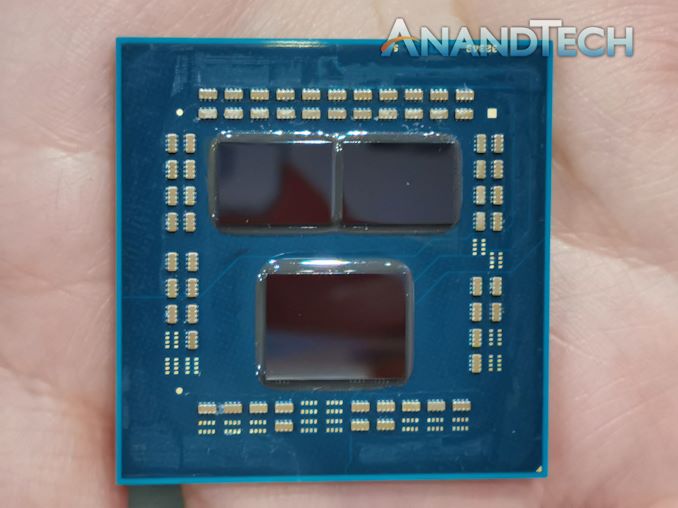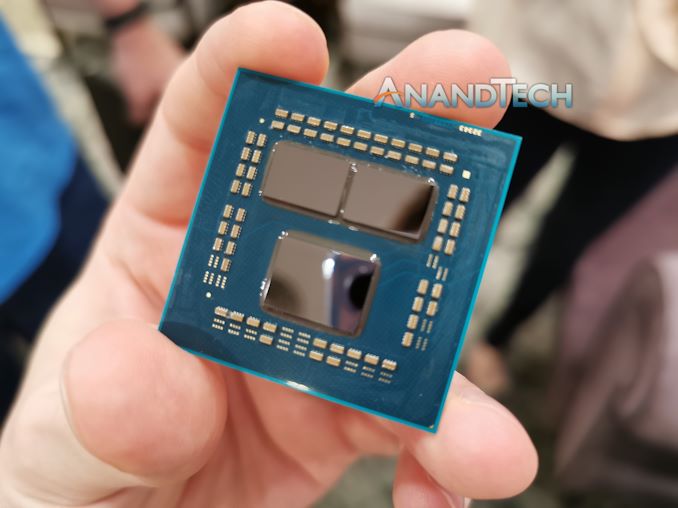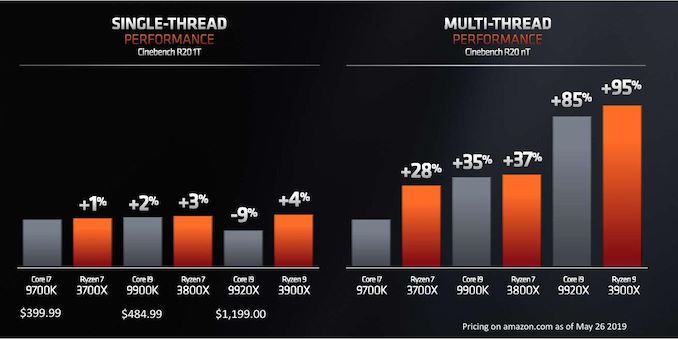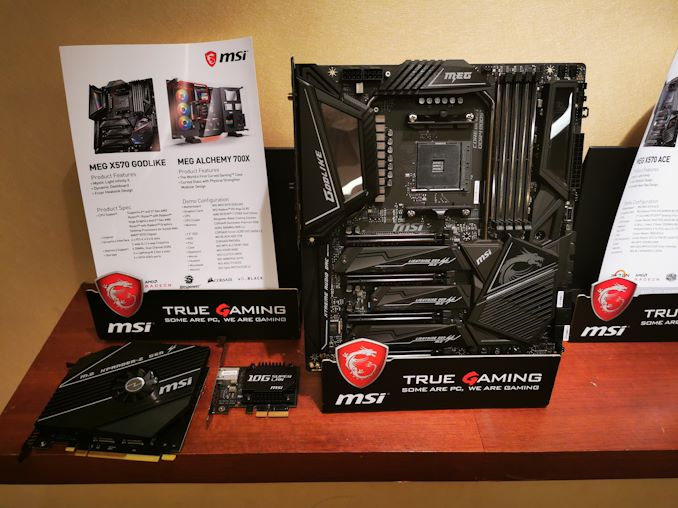AMD Ryzen 3000 Announced: Five CPUs, 12 Cores for $499, Up to 4.6 GHz, PCIe 4.0, Coming 7/7
by Ian Cutress on May 26, 2019 11:30 PM EST- Posted in
- CPUs
- AMD
- Trade Shows
- Ryzen
- Zen 2
- Ryzen 3000
- Ryzen 3rd Gen
- Matisse
- Computex 2019

Today at Computex, AMD CEO Dr. Lisa Su is announcing the raft of processors it will be launching on its new Zen 2 chiplet-based microarchitecture. Among other things, AMD is unveiling its new Ryzen 9 product tier, which it is using for its 12-core Ryzen 9 3900X processor, and which runs at 4.6 GHz boost. All of the five processors will be PCIe 4.0 enabled, and while they are being accompanied by the new X570 chipset launch, they still use the same AM4 socket, meaning some AMD 300 and 400-series motherboards can still be used. We have all the details inside.
A lot of people have been after details about AMD’s next generation Ryzen platform for several months, ever since AMD teased the Matisse Ryzen 3000 design at CES back in January. Most of that information is coming out today, with Ryzen 9, Ryzen 7, and Ryzen 5 processors in the mix. All of these processors will be officially launched on July 7th (which is 7/7), correlating with the fact that the core chiplets of these products are built on TSMC’s 7nm process. This is technically a Sunday, but AMD doesn’t mind too much. In reality, it means users might even get them in the mail on the following Monday.
Before talking about features, let’s go straight into the CPU list, as that’s what most of you are here for.
| AMD 'Matisse' Ryzen 3000 Series CPUs | |||||||||||
| AnandTech | Cores Threads |
Base Freq |
Boost Freq |
L2 Cache |
L3 Cache |
PCIe 4.0 |
DDR4 | TDP | Price (SEP) |
||
| Ryzen 9 | 3900X | 12C | 24T | 3.8 | 4.6 | 6 MB | 64 MB | 16+4+4 | ? | 105W | $499 |
| Ryzen 7 | 3800X | 8C | 16T | 3.9 | 4.5 | 4 MB | 32 MB | 16+4+4 | ? | 105W | $399 |
| Ryzen 7 | 3700X | 8C | 16T | 3.6 | 4.4 | 4 MB | 32 MB | 16+4+4 | ? | 65W | $329 |
| Ryzen 5 | 3600X | 6C | 12T | 3.8 | 4.4 | 3 MB | 32 MB | 16+4+4 | ? | 95W | $249 |
| Ryzen 5 | 3600 | 6C | 12T | 3.6 | 4.2 | 3 MB | 32 MB | 16+4+4 | ? | 65W | $199 |
The New Flagship: Ryzen 9 3900X
The Ryzen 3000 series will debut a new product tier for AMD: Ryzen 9. In this case, the Ryzen 9 3900X will be AMD’s first mainstream desktop 12-core processor. The processor is the only one of the group that uses two chiplets, in a 6+6 configuration. The 3900X will have a base frequency of 3.8 GHz, a turbo frequency of 4.6 GHz, and line up with 6 MB of L2 cache and 64 MB of L3 cache. This confirms that each chiplet has 32 MB of L3 cache, doubling what we saw on the first generation of the Zen microarchitecture. This CPU has a TDP of 105W, which for AMD processors is usually a good measure of all-core power consumption, and will be enabled with 24 PCIe 4.0 lanes (16 for GPU, 4 for storage, 4 for the chipset).
| AMD 'Matisse' Ryzen 3000 Series CPUs Ryzen 9 |
|||||||||||
| AnandTech | Cores Threads |
Base Freq |
Boost Freq |
L2 Cache |
L3 Cache |
PCIe 4.0 |
DDR4 | TDP | Price (SEP) |
||
| Ryzen 9 | 3900X | 12C | 24T | 3.8 | 4.6 | 6 MB | 64 MB | 16+4+4 | ? | 105W | $499 |
The Ryzen 9 3900X will have a suggested e-tail price of $499, and it will come with a cooler (more details in the coming weeks). AMD compared this processor in its presentations to Intel’s 12-core HEDT processor, the Core i9-9920X, which has an MSRP of $1199 and doesn’t come with a cooler.
In this comparison, AMD provided Cinebench R20 performance data comparing the two processors (it should be noted that we can’t confirm these results at this time). AMD states that in single thread performance, the 3900X beats the 9920X by +14%, and also wins in multi-threaded performance by 6%, all while having a lower TDP (165W vs 105W).
The Ryzen 9 3900X is the new mainstream desktop flagship, although AMD clearly has enough headroom on this design to enable a full 16 cores. Most users will expect this to come in the future, so it will be interesting to see if AMD will strategically play this card.
Mainstream Madness: Ryzen 7 at 65W
For the Ryzen 7 lineup, AMD is keeping this for the 8-core versions. These CPUs only have a single chiplet inside, and no dummy chiplet. Of the two CPUs in this segment, the one that gets a big shock from us is actually the cheaper model.
| AMD 'Matisse' Ryzen 3000 Series CPUs Ryzen 7 |
|||||||||||
| AnandTech | Cores Threads |
Base Freq |
Boost Freq |
L2 Cache |
L3 Cache |
PCIe 4.0 |
DDR4 | TDP | Price (SEP) |
||
| Ryzen 7 | 3800X | 8C | 16T | 3.9 | 4.5 | 4 MB | 32 MB | 16+4+4 | ? | 105W | $399 |
| Ryzen 7 | 3700X | 8C | 16T | 3.6 | 4.4 | 4 MB | 32 MB | 16+4+4 | ? | 65W | $329 |
The Ryzen 7 3700X is an eight core, sixteen thread CPU with a 3.6 GHz base frequency and a 4.4 GHz turbo frequency. It has 4 MB of L2 and 36 MB of L3 (half the L3 compared to Ryzen 9, because it only has one chiplet), but the amazing thing is that this chip has a TDP of just 65W. Just on paper, it looks like this processor is one of the most efficient x86 performance desktop processors ever made. This is likely the CPU configuration that AMD used in its Cinebench R20 demo back at CES, where it showed R20 equivalent multithreaded performance for 40% less system power. And the price for all this performance? Only $329. If I put my reviewer hat on and look at these specifications at a high level, the Ryzen 7 3700X promises to be the mainstream chip of choice for a substantial number of high-performance PCs this year.
Like with the Ryzen 9 3900X, AMD also ran a Cinebench comparsion with the 8 core Ryzen 3700X versus Intel's mainstream Core i7-9700K. Here they scored 4806, verus 3726 for the 9700K in R20's multithreaded test.
The other CPU in this bracket is the Ryzen 7 3800X. This is going to be the direct upgrade from the current Ryzen 7 2700X, comes with eight cores and sixteen threads, with a base frequency of 3.9 GHz and a boost frequency of 4.5 GHz. It doesn’t seem overly impressive compared to the 3700X with its larger 105W TDP for only a few hundred MHz more on the base frequency, however as we’ve seen with the 2nd Gen Ryzen, that extra TDP headroom usually helps with technologies like XFR that manage the boost frequencies. AMD hasn’t said anything new about how XFR or Precision Boost works in the new generation yet, we have to wait until nearer launch for that information. However the extra frequency and extra TDP will cost an extra $70: the Ryzen 7 3800X will retail for $399.
Budget Builds: Ryzen 5 with Six Cores
Not mentioned during the keynote, but discussed in the press release, AMD also gave information about its new Ryzen 5 processors.
| AMD 'Matisse' Ryzen 3000 Series CPUs Ryzen 5 |
|||||||||||
| AnandTech | Cores Threads |
Base Freq |
Boost Freq |
L2 Cache |
L3 Cache |
PCIe 4.0 |
DDR4 | TDP | Price (SEP) |
||
| Ryzen 5 | 3600X | 6C | 12T | 3.8 | 4.4 | 3 MB | 32 MB | 16+4+4 | ? | 95W | $249 |
| Ryzen 5 | 3600 | 6C | 12T | 3.6 | 4.2 | 3 MB | 32 MB | 16+4+4 | ? | 65W | $199 |
These are still very competitive – users can now buy a six-core processor for under $200. The processor frequencies are commensurate with the position in the stack, along with the pricing, and both CPUs will support all the same technologies (PCIe 4.0, etc) as the bigger chips. These chips still use a single chiplet, not a dual chiplet design.
Performance Numbers
AMD provided some performance numbers to compare AMD to Intel CPUs. All of these tests are using Cinebench R20, which should be noted is a floating point rendering test that AMD already does well on, but there aren’t any specific optimizations here for each CPU.
Direct chip to chip comparisons put AMD’s single thread performance against Intel at +1%. Though it should be noted here that something like the Ryzen 7 3800X, which boosts to 4.5 GHz, is being compared to an Intel CPU that boosts to 5.0 GHz. That would put IPC on this test firmly in the hands of AMD. Multi-threading results are a similar scenario, although the margin of difference tends to drop the more cores that AMD has access to, perhaps because more cores are fighting to get to the memory with a slightly extended memory latency compared from Intel.
Comparing Zen 1 to Zen 2, AMD is promoting that the Ryzen 9 3900X offers +32% better single threaded performance over the Ryzen 7 1800X. Given that we saw a 40-52% IPC increase from pre-Zen to Zen 1, another +32% on single threaded performance is a good amount to have, although that 32% does include frequency uplift. When we get the chips in, we’ll do an obvious comparison test to find the IPC difference. In multi-threaded results, AMD is promoting +100% multithreaded performance, which is helped by +50% more cores, 2x better FP throughput per core, and higher frequencies.
Other Features and X570 Motherboards
Aside from the 7nm chiplets, and the monumental price comparison to Intel, there are some other features to mention. AMD is promoting a +15% direct IPC increase from Zen 1 to Zen 2, due to microarchitecture improvements and cache size doubling on the L3. The CPU has 24 PCIe 4.0 lanes: sixteen for the GPU (or other PCIe cards), four for storage, and four for the chipset. The four for storage will likely be linked to the top M.2 slot. Given that some companies are advertising PCIe 4.0 SSDs here at Computex, we expect more to follow in due course.
The new X570 chipset has 16 lanes, four for the upstream connection to the CPU, and twelve downstream for other devices. There is some discontinuity here – we heard from partners that AMD actually removed four PCIe lanes from the chipset design in order to bring the TDP of the chipset down from 15W to 11W; but the full-fat 15W version will be on the next editions of the high-end desktop (which would suggest that Threadripper isn’t dead, contrary to a lot of reporting – this is a question we will be asking Lisa Su later today). We have already seen a number of X570 motherboards ready to enter the market, and we expect around 25 new X570 models in total. It is clear that motherboard manufacturers are now getting serious on AM4 – some of these boards are likely to retail up to $600. These manufacturers are clearly expecting AMD to hit Intel hard, and have designed the motherboards to match the best that they make for Intel's CPUs.
One bit of information not disclosed is memory support, however given our discussions with AMD’s partners, this is likely to be DDR4-3200 in one module per channel mode. This is a small bump over 2nd Gen Ryzen, but still a welcome one. It will be interesting to see how the memory controller works on this design for pushing that frequency. The memory frequency and Infinity Fabric frequency are still linked as before, so bumping up the memory frequency has additional benefits.
Finally, the release date for all these CPUs is going to be July 7th. We’re waiting on AMD to disclose the sampling time frame, but our aim is to get our review up on day one. Suggestions for the review are most welcome.
We also have access to Dr. Lisa Su directly after the keynote today, and will write up our Q&A in due course. Stay tuned for that.
| Want to keep up to date with all of our Computex 2019 Coverage? | ||||||
 Laptops |
 Hardware |
 Chips |
||||
| Follow AnandTech's breaking news here! | ||||||
















307 Comments
View All Comments
ChubChub - Monday, May 27, 2019 - link
I work for a relatively small ISP (~50 racks), and all of OUR new server purchases are exclusively being quoted out as Epyc (customers are loading whatever they want).At least by us, and I expect others, QuickAssist is largely seen as an unnecessary backdoor of likely poor security, and with dubious value. As well, Intel's Meltdown/Spectre/Fallout/etc vulnerabilities that have greatly reduced the processing power that we purchased is deplorable, and further erodes our faith in proprietary Intel implementations. On top of that, we also see QuickAssist as an unnneccessary "lock-in" to a CPU architecture, which is very bad business for people like us.
Having said that, as far as I know, AMD does not have an equivalent, but I doubt it matters to most people, as cost/performance, density (very important for us), security, and availability are the main decision points, and the new Epyc chips win on all fronts.
Gondalf - Monday, May 27, 2019 - link
Too bad your words are not assisted by hard facts or numbers, and AMD market share remain really low. Be careful, likely there is a security hole in your new SKU that you don't know because nobody have given notice of it.Marketing post.
just4U - Monday, May 27, 2019 - link
Their 64 core 7nm Rome CPU's might boost their market share.. no?just4U - Monday, May 27, 2019 - link
This is what I heard about the Rome CPU according to articles.It's the first to support PCIE 4.0, is a drop in replacement for existing boards, has 4x the floating point power of the previous gen, and 2x the speed per socket over naples. They showed a demo of 1 Rome cpu beating 2 flagship intels in a rendering test..
I don't know a whole helluva lot about cpu's like that but it sounds impressive..
zmatt - Monday, May 27, 2019 - link
AMDs numbers have grown supstantially in the enterprise space in the last two years. Intel still has the majority but these things don't happen overnight. Somebody is buying a lot of epyc based systems though and the extra attention given by cloud providers like Amazon means you should take it seriously.I don't admin nearly as many systems as OP but I am also looking at epyc for out next VM cluster later this year. And it really does come down to price/performance. They have a much more sensible upgrade path and road map too.
just4U - Monday, May 27, 2019 - link
Price/Performance has always been a selling point for AMD.. but from speculation by others it appears AMD will be competing with Intel across just about every sector and not just at certain price points.. either matching or beating them outright. Something that we haven't really seen before. It's gotten a lot of people really excited and should certainly bode well for all of us as Intel will be forced to compete on pricing as well as innovation.vFunct - Monday, May 27, 2019 - link
Going to be hard for AMD to compete against the very datacenter focused Intel Xeon products, with optimizations for video transcoding, as well as FPGA accelerators.zmatt - Monday, May 27, 2019 - link
Depends on what you are doing. The vast majority of businesses do not use their servers for video transcoding. Most of the work done is pretty mundane. AD domain controllers, SMB file servers, SQL servers, VDI and application hosting.Users with more specific needs will have to be more discerning but for everyone else its a simple price/performance arithmetic.
Santoval - Monday, May 27, 2019 - link
"Marketing post".Do you mean your own post?
Bulat Ziganshin - Wednesday, May 29, 2019 - link
it may seem sensible unless they have 8c for $300, so 16c $600 is even easier to produce